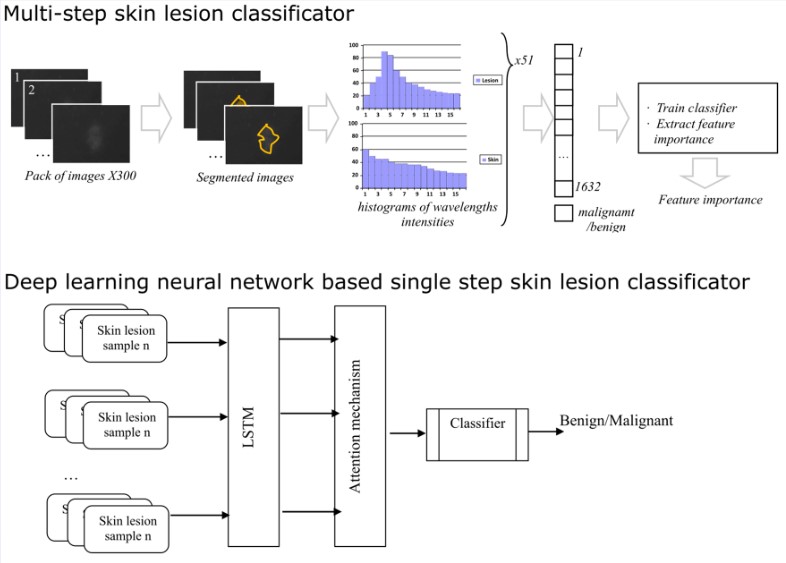Project title:
"Skin cancer early diagnostics accuracy improvement by using neural networks"
Project contract number:
lzp-2018/2-0052
Project implementation deadline:
01.12.2018. – 01.12.2020.
Total project funding:
200 000,00 EUR
Research manager:
Ilze Ļihačova (Biophotonics laboratory)
About the project:
The project aims to develop and clinically test a new type of portable device for early diagnosis of skin cancer. The diagnostic process will consist of obtaining spectral and fluorescent parametric images under specific illumination and processing them using artificial neural networks. The prototype device and image processing neural network algorithm will be clinically tested on a variety of malignant and benign skin formations at the Latvian Oncology Center under the guidance of a highly qualified oncologist. The development of such a device will significantly improve the availability of early diagnosis and post-operative monitoring of skin cancer, increasing the life expectancy and quality of human life. The research team of the project will consist of experienced biophotonics, electronics and oncology experts, as well as young scientists from the University of Latvia (UL) and Riga Technical University (RTU).
Projekta rezultāti:
Paredzētās aktivitātes līdz projekta beigām | Skaits |
Zinātniskās publikācijas zinātniskajos žurnālos, kuru citējamības indekss sasniedz vismaz 50% no nozares vidējā. | 1 |
Zinātniskās publikācijas, kas indeksētas SCOPUS, WoSCC un/vai ERIH+ | 5 |
Intelektuālā īpašuma nostiprināšana (ASV vai ES pagaidu patentu pieteikums) | 1 |
Dalība starptautiskās zinātniskās konferencēs | 4 |
Atsauce publicitātei (reference for publicity):
LV: Pētījums tiek īstenots ar Latvijas Zinātņu padomes finansējuma atbalstu projektā “Ādas vēža agrīnas diagnostikas precizitātes uzlabošana ar neironu tīkliem” (vienošanās Nr: lzp-2018/2-0052).
ENG: This work has been supported by Latvian Council of Science funded project “Skin cancer early diagnostics accuracy improvement by using neural networks” (agreement No: lzp-2018/2-0052).
Publikācijas:
- Katrina Bolochko, Dmitrijs Bliznuks, Dilshat Uteshev, Ilze Lihacova, Alexey Lihachev, Yuriy Chizhov, and Andrey Bondarenko "Towards to deep neural network application with limited training data: synthesis of melanoma's diffuse reflectance spectral images", Proc. SPIE 11074, Diffuse Optical Spectroscopy and Imaging VII, 110741O (11 July 2019); https://doi.org/10.1117/12.2527173
- D. Bliznuks, Y. Chizhov, A. Bondarenko, D. Uteshev, A. Lihachev, I. Lihacova, “Identification of the most informative wavelengths for non-invasive melanoma diagnostics in spectral region from 450 to 950 nm,” SPIE Saratov Fall Meeting 2019, 23-27 September, Saratov, Russia. (Submitted, will be published).
-
A. Bondarenko, Y. Chizhov, D. Uteshev, D. Bliznuks, A. Lihachev, and I. Lihacova "Use of machine learning approaches to improve non-invasive skin melanoma diagnostic method in spectral range 450 - 950nm", Proc. SPIE 11353, Optics, Photonics and Digital Technologies for Imaging Applications VI, 113531D (2020).
-
D. Bliznuks, E. Cibulska, A. Bondarenko, Y. Chizhov, I. Lihacova, “Deep learning model deploying on embedded skin cancer diagnostic device,” SPIE Proc, Third International Conference Biophotonics Riga 2020 (submitted)
-
J. Spigulis, I. Kuzmina, I. Lihacova, V. Lukinsone, B. Cugmas, A. Grabovskis, E. Kviesis-Kipge, A. Lihachev, “Biophotonics research in Riga: recent projects and results,” SPIE Proc, Third International Conference Biophotonics Riga 2020 (submitted).
Dalība konferencēs:
- Katrina Bolocko, Dmitrijs Bliznuks, Dilshat Uteshev, Ilze Lihacova, Alexey Lihachev, Yuriy Chizhov, Andrey Bondarenko, “Towards to deep neural network application with limited training data: synthesis of melanoma's diffuse reflectance spectral images,” SPIE European Conferences on Biomedical Optics, 23-27 June 2019, Munich, Germany.
- D. Bliznuks, Y. Chizhov, A. Bondarenko, D. Uteshev, A. Lihachev, I. Lihacova, “Identification of the most informative wavelengths for non-invasive melanoma diagnostics in spectral region from 450 to 950 nm,” SPIE Saratov Fall Meeting 2019, 23-27 September, Saratov, Russia.
-
Y. Chizhov, A. Bondarenko, D. Uteshev, D. Bliznuks, I. Lihacova, A. Lihachev, “Use of machine learning approaches to improve non-invasive skin melanoma diagnostic method in spectral range 450 – 950 nm,” SPIE Photonics Europe 2020, Optics, Photonics and Digital Technologies for Imaging Applications VI, 11353-48 (2020).
-
J. Spigulis, I. Kuzmina, I. Lihacova, V. Lukinsone, B. Cugmas, A. Grabovskis, E. Kviesis-Kipge, A. Lihachev, “Biophotonics research in Riga: recent projects and results,” Third International Conference Biophotonics Riga 2020, Programme and Book of Abstracts, pp.12 (2020).
-
D. Bliznuks, E. Cibulska, A. Bondarenko, Y. Chizhov, I. Lihacova, “Deep learning model deploying on embedded skin cancer diagnostic device,” Third International Conference Biophotonics Riga 2020, Programme and Book of Abstracts, pp.32 (2020).

 CONFERENCE
CONFERENCE